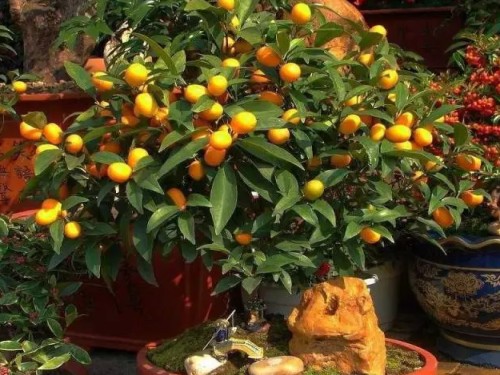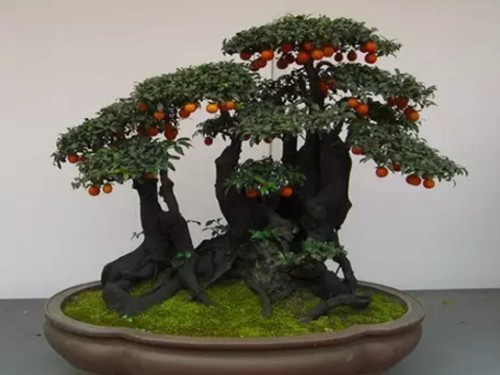How to trim the bonsai of fruit trees
The excellent works of fruit tree bonsai not only have the harvest beauty of fruit tree cultivation, but also have the artistic beauty of Chinese traditional bonsai, which has its own distinct style and characteristics. When there are too many bonsai branches of fruit trees, it is easy to cause scattered nutrients, lack of internal light, poor fruit quality and so on. Therefore, before the sprouting of fruit trees in spring, cross branches, overlapping branches, disease and insect branches and overgrown branches should be cut off, which is basically consistent with the pruning of other orchid gardens, which is called basic pruning.
In the summer fruit growth period, by coring, sprouting, cutting and other means to control the tree shape, and to prevent the formation of apical dominance, to promote the growth and expansion of fruit. In autumn, in order to improve the ornamental effect of bonsai of fruit trees, we should give priority to shaping, cut off the branches that affect the ornamental effect, and remove the leaves that cover the fruit.

Bonsai pruning of fruit trees should grasp the following principles:
1. Look at the age of trees: for young trees, in order to increase the number of branches and leaves, expand the crown and form a good structure as soon as possible, winter pruning should be carried out from November to December. For the prosperous trees of suitable age, the winter pruning time can be postponed to sprouting in early spring. For the weak trees in the full fruit period, in order to promote their vegetative growth and quickly restore the strong tree potential, the task of winter pruning should be completed before the end of December.
In order to weaken the tree potential and form more flower buds, the tree can be cut in winter from January to February. According to the strength of the tree, it is necessary to grasp the pruning degree from the whole and the part, and maintain the balance of the tree potential as a whole. The crown is complete and compact, the master and slave are distinct, the plane is dense, the upper backbone branches are obviously shorter than the lower backbone branches, the subordinate branches make way for the dominant branches, and the growth potential of the backbone branches in the same layer is approximately the same. As long as it can achieve the goal of firm, compact, ventilated and transparent early fruit and high yield of early fruit, it can be arranged and dredged with its original tree shape and tree potential, and must not put too much emphasis on shaping, especially for young trees, which often lead to premature fruit.
2. Look at what the branches look like:
Bonsai of strong and weak fruit trees on ①: the upper strong branch is cut back, the weak head is replaced, and even the upper strong part is sawed off, and the lower weak branch is heavily truncated from the full bud at the base of the main branch.
Bonsai of fruit trees with inconsistent growth potential of the main branches at the base of ②: the strong main branches are cut together, and the thin main branches are truncated from the plump buds at the top.
Bonsai of fruit trees without side branches and inner bore branches of ③: choose the best upright branches to be pulled to a reasonable position with rope, too dense thinning.
Bonsai of fruit trees without tree shape in ④: sawing off some obviously superfluous branches, opening the distance between layers, selecting backbone branches for key training, long-term planning, using "pull, support, press" and other means to make the tree structure as reasonable as possible. If there are few or no flower buds, more throwing, more thinning, and less cutting should be done.
3. Look at the pruning response:
If the one-year-old branches on the 3-year-old branches are large and stout, the buds are full, the growth length is significantly smaller than that of the extended branches, and there are some foliage branches, indicating that the amount of pruning in the previous years is suitable and can continue to be used in the same year. If the length of the 1-year-old branch on the 3-year-old branch is similar to or more than that of the extended branch, it indicates that the pruning amount in the previous years is too large, so it should be cut lightly in the same year. If there are no medium and short branches on the 3-year-old branches, but only some clumps of leaves with very small leaves, it shows that the pruning amount in previous years is too light, so that it should be heavily pruned in the same year; look at the number of flower buds: it is necessary to work up and down locally to make a suitable proportion of flower buds and leaf buds, generally 1 ∶ 2 to 3.
4. The principle of "three sparse and three densities", that is, the big branches are sparse, the branchlets are dense, the outer branches are sparse, the inner branches are dense, the upper branches are sparse, and the lower branches are dense. "one big and one small" means: the lower part is big and the upper part is small.
5. The treatment of branches and twigs of bonsai of fruit trees.
Results the branch group should be retracted, rejuvenated and renewed in time in order to maintain the robust result potential. For other branches, a new branch group is formed after processing. Strong trees and branches should be released more slowly and cut less, and then retract after weakening. For the branches that have overgrown, they should be rejuvenated in time and cultivated into fruiting branches. For the upper branches of the back, not all should be removed, but also should be used according to the situation. The young trees are strong, and the upper branches on the back are easy to grow, which can be controlled by the methods of picking the heart, pulling branches and taking branches in the summer pruning, and become useless into useful; the tree potential in the peak period has been stable, and the upper branches on the back are not easy to grow, and the choice can be made according to the space and position; for the old trees after the full fruit period, the branches on the back should be fully utilized in order to renew the tree potential and prolong the fruiting life.
6. the method of thinning the branches of bonsai fruit trees:
First of all, you can't go small or big. That is to say, when thinning branches, we should first consider removing the big branches, and then consider removing the twigs, so as to prevent the phenomenon of "light stick" of the whole plant.
Second, trees with too many branches can not be thinned too much at one time, but can be removed year by year, not more than two at a time.
Third, do not remove two opposite branches at the same time, causing mouth-to-mouth injury, so as not to weaken the upper tree potential.
The fourth wound should be disinfected and protected. It can be disinfected with 2% copper sulfate solution or stone-sulfur mixture, and coated with paraffin wax or antirust paint to prevent the invasion of bacteria and evaporation of water in the tree.
7. Disinfect the pruning tools. Tools often come into contact with scars because of carelessness, so it is necessary to disinfect them with Baume 3-5 degree stone sulfur mixture or 50 times Fumei arsenic solution in time to prevent the spread of bacteria.
Time: 2019-06-10 Click:
- Prev

How to trim the bonsai of honeysuckle
Pruning of Flos Lonicerae is an effective technical measure to regulate stem growth, promote flower bud differentiation, prolong plant life and stabilize high yield. After pruning, honeysuckle can generally increase production by 35-45%, and the highest is more than twice as high. After taking pruning measures for honeysuckle plants that have entered the aging period
- Next

Modeling Technology of Fruit Tree Bonsai
Bonsai fruit trees have both shape and fruit, brilliant characteristics, ornamental value all the year round, exquisite flowers in spring, luxuriant branches and leaves in summer, plenty of fruit in autumn, vigorous in winter, full of interest in life. The bonsai of fruit trees should have a certain shape and artistic conception. According to the species and variety characteristics of fruit trees
Related
- Fuxing push coffee new agricultural production and marketing class: lack of small-scale processing plants
- Jujube rice field leisure farm deep ploughing Yilan for five years to create a space for organic food and play
- Nongyu Farm-A trial of organic papaya for brave women with advanced technology
- Four points for attention in the prevention and control of diseases and insect pests of edible fungi
- How to add nutrient solution to Edible Fungi
- Is there any good way to control edible fungus mites?
- Open Inoculation Technology of Edible Fungi
- Is there any clever way to use fertilizer for edible fungus in winter?
- What agents are used to kill the pathogens of edible fungi in the mushroom shed?
- Rapid drying of Edible Fungi

